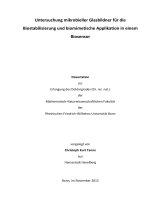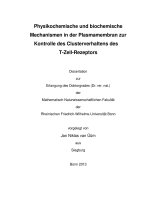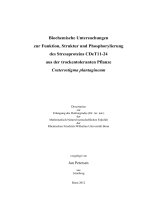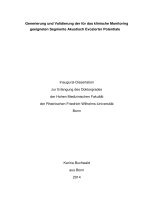Berichte des Institutes für Geologie und Paläontologie, K.-F.-Universität Graz Vol 4-0049-0059
Bạn đang xem bản rút gọn của tài liệu. Xem và tải ngay bản đầy đủ của tài liệu tại đây (2.28 MB, 11 trang )
IBer. lnst. Geo/. Paläont., K.-F.-Univ. Graz
©Institut f. Erdwissensch., Geol. u. Paläont., Karl-Franzens-Universität Graz; download www.biologiezentrum.at
Band 4, Graz 20011
Mid-Miocene Circum-Mediterranean paleogeography
Fred RÖGL
Geologisch-Paläontologische Abteilung, Naturhistorisches Museum Wien,
Burgring 7, A- 1014 Wien, Austria
A brief overview of the Circurn-Mediterranean paleogeography (RöGL 1 998, 1 999) is given
to stirnulate the discussion on open problerns. There are excellent reconstructions on the
paleogeography and sedirnent distribution of the Oligocene - Early Miocene of the Eastem
Paratethys (POPOV et al. 1 993). A Middle Miocene (Badenian) paleogeographic
reconstruction of the Paratethys was presented by STUDENCKA et al. ( 1 998), but is based on a
different Stratigraphie correlation. Fig. 1 shows the present correlation of the Central and
Eastern Paratethys as proposed by the author. The correlation with the absolute time-scale
follows BERGGREN et al. ( 1 995); the differences of the Langhian-Serravallian boundary
depend on different interpretations, and a rnissing boundary-stratotype (FORNACIARI et al.
1997).
:::c
(.)
0
0..
UJ
AGE
CENTRAL
PARATETHYS
STAGES
EASTERN
PARATETHYS
STAGES
ZANCLEAN
DAClAN
KIMMERIAN
LU
z
UJ
ü
0
MESSINIAN
PONTIAN
PONTIAN
"'
TORTONIAN
Q
�
-' LU
Cl. U
5
�
1 0 ····
-
15
<0
-'
7.1
11.0
LU
z
LU
ü
0
�
:z
Vienna
Basin
�F
z Molda�
� vian
� 0-E
0
Z
�
c
z
�
Olteanian
Khersonian
.
:;:
NB --- ' -------��--_Ba,�sar
1 L5
SARMATIAN
jJ3,0L___
�
BADENIAN
�
"'
::J
;;;
0
�
"'
.s!
"'
U
��
��
MN
NN13
14
P L1
MN
______M_1L_
13
�
6 0
d
<
:::::: c
"' "'
Z ii.
MAEOTIAN
a
11 0.0)
Khersonian
Bess-
arabian
Vu!llynian
MN 9
MN
8-7
Konkian
Karaganian
OJ
'0
"0
BI OZON ES
Tshokrai<.ian
MN 6
M12
M11M8
.
NN9b
NN9ai8
NN7
NN6
M7
1.6..4
M4
20
M3
LU
z
LU
ü
�
NN4
NN3
M2
20.5
>,
�
LU
KARADZHALGAN
�-� :�---
EGERIAN
Fig.
25
30
LU
z
LU
u
0
(!)
::J
0
(27 5)
RUPELIAN
KISCELLIAN
LU
z
LU
u
0
LU
.El
"'
--'
SOLENOVIAN
PSHEKIAN
33.7
35 ...
KALMYKIAN
PRIABON IAN
PRIABONIAN
BELOGLINIAN
1:
Correlation of
Eastem
Central
and
stages
(in
Paratethys
cooperation with DAXNER
HöcK and liARZHAUSER;
planktic zonation acc. to
BERGGREN et al. 1 995 ;
acc.
to
marnrnals
Scffi.UNEGGER et al. 1 996
and AGUSTI et al. 200 1 ;
Paratethys acc. to RöGL
1 998).
49
©Institut f. Erdwissensch., Geol. u. Paläont., Karl-Franzens-Universität Graz; download www.biologiezentrum.at
Band 4, Graz 20011
IBer. lnst. Geol. Paläont., K.-F.-Univ. Graz
Aquitanian - Late Egerian - Ka radzhalgan (NNl to lower NN2) (Fig. 2)
- �
--�
\ (
I
RÖGL, 2001
Aq u ita n i a n - Late Egerian - Ka radzh a l g a n
Fig. 2: Paleogeography of Aquitanian - Late Egerian - Karadzhalgan, at 2 3 Ma.
In the Late Oligocene (nannoplankton zone: upper NP25) marine Connections between the
Paratethys and the Iranian basins were restored. Similar mollusc faunas and tropical larger
foraminifera appear from the Qom B asin (Iran) to the Mediterranean (e.g., Mesohellenie
Basin), and to the Centrat Paratethys (northem Hungary-southem Slovakia). Typical larger
foraminifera are lepidocyclinas, miogypsinids, and Cycloclypeus; altogether about 1 0 species
in the Centrat Paratethys (BALD! et al. 1 999). According to JONES ( 1 999) the number of
species of Aquitanian larger foraminifera in the northern Mediterranean and southern Europe
was 1 5 , in Southeast Asia 2 7, but only 4 in East Africa. The distribution reflects current
systems in the Indian Ocean and the Mediterranean. In Karadzahlgan time warm water
immigrants, similar to those of the Centrat Paratethys appeared in the Eastem Paratethys
(POPOV et al. 1 993).
Teetonic activity increased in the Late Oligocene throughout the Mediterranean. The
overthrust of the Apennine nappes started in a northeasterly direction and counterclockwise
rotation (BOCCALETTI et al . 1 990). The Alpine Foredeep was closed since the middle
Oligocene, brackish "Cerithium Beds" in the Rhine Graben had no exchange with the
Paratethys or the Mediterranean (SISSINGH 1 998, REICHENBACHER 2000). A connection of the
Centrat Paratethys to the open sea existed through the Slovenian corridor. The conditions in
the Molasse Basin make it likely that a second connection existed southward from the
Salzburg area to the Po Basin (WAGNER 1 996).
50
lßer. lnst. Geol. Paläont., K.-F.-Univ. Graz
©Institut f. Erdwissensch., Geol. u. Paläont., Karl-Franzens-Universität Graz; download www.biologiezentrum.at
Band 4, Graz 20011
Early Burdigalian - Eggenburgian - Sakaraulian (upper NN2 to lower NNJ)
Teetonic movements changed the configuration of the Alpine-Carpathian-Dinaride belt with
begin of the B urdigalian/Eggenburgian (FoooR et al. 1 998). The Western Paratethys B asin
opened again along the Alpine chain to connect with the western Mediterranean (SISSINGH
1 997). The Slovenian corridor closed. In the Eastern Paratethys, the seaway remained open
towards the Indian Ocean.
The Early B urdigalian/Eggenburgian mollusc faunas are similar in the Central Paratethys
(from the Bavarian Molasse eastward), in the Eastern Paratethys (Sakaraulian Sea), and in the
Qom B asin (Iran). The proposed Indopacific connection as indicated by a horizon of giant
pectinids (AoDICOTT 1 974, B ALDI 1 979) is not as weil developed in other faunal elements.
Otherwise there existed subtropical conditions and Indian elements, e.g., the crocodile
Gavialosuchus in the bay of Eggenburg (Central Paratethys).
Late Burdigalian - Ottnangian - Early Kotsa khurian (upper NNJ - lower NN4) (Fig. 3)
--
- -----
)
�·
RÖGL, 2001
Late B u rd i g a l i a n - Ottn a n g i a n - Early Kotsa kh u ri a n
Fig. 3 : Paleogeography of Late Burdigalian - Ottnangian - Early Kotsakhurian, at 1 8 Ma.
The counter-clockwise rotation of Africa and Arabia resulted in a collision with the Anatolian
plate. For a first time the Mediterranean was cut off from the Indopacific. The Mediterranean
became a giant embayment of the Atlantic. The newly formed landbridge, called the
"Gomphotherium Landbridge" enabled a continental faunal exchange between South and
North. The invasion of proboscideans, e.g., Gomphotherium in Eurasia is an indicator for this
important event.
These tectonic activities cut off also the Eastern Paratethys from open marine Connections,
and the endemic Kotsakhurian facies with reduced salinity developed, similar to the modern
Caspian Sea. Characteristic are the bivalves R=ehakia ("Oncophora ") , Cerastoderma, and
51
IBer. lnst. Geol. Paläont., K.-F.-Univ. Graz
©Institut f. Erdwissensch., Geol. u. Paläont., Karl-Franzens-Universität Graz; download www.biologiezentrum.at
Band 4, Graz 20011
Siliqua. In the eastern part of the Carpathian Foredeep evaporites were deposited in the area
of the Ukraine and Romania. Otherwise the Rhine Graben opened again for a shallow
connection with the North Sea. The faunas in the Western and Centrai Paratethys are
characterised by boreal and Atlantic influences.
Already at this time problems arise for an eastem marine connection of the Central
Paratethys, especially of the Transylvanian Basin with the Eastem Mediterranean.
Interestingly, the foraminiferal assemblages of small globigerinas show identicai species of
the Ottnangian in the Central Paratethys, in North Anatolia around Trabzon, and also in the
South, in the Antalya B asin (BrzoN et al . 1 97 4 ).
Latest Burdigalian - Late Karpatian - Late Kotsakhurian (NN4 p.p.) (Fig. 4)
'
. c;:; ,
I
-- -- -
�
- ---- - - -
\
I
RÖGL,
2001
\
Latest B u rd ig a l i a n - Late Ka rpati a n - Late Kotsak h u ri a n
Fig. 4: Paleogeography of latest Burdigalian - Karpatian - Late Kotsakhurian, at 1 6 . 7 Ma.
The regional re-organisation came to its peak during the Styrian tectonic phase. By the end of
Ottnangian a far spread regression occurred in the Central Paratethys. Rzehakia faunas,
similar to those of the Kotsakhurian developed in the estuarine areas. A tumover from W -E
stretching elongated basins to an intra-mountain basin configuration occurred. During the
Karpatian the Alpine Foredeep became dry land, as it was also in the Transylvanian B asin.
Microfaunas of the Transylvanian Basin do not yield the Karpatian Globigerinoides
bisphericus horizon, but show already Praeorbulina as indicator of the Middle Miocene.
The Styrian phase was active throughout the Mediterranean and re-opened the marine
connection with the Indian Ocean. This opening may have occurred already as early as the
latest B urdigalian as indicated by mollusc faunas in the Mut B asin (southern Anatol ia). Such
subtropical mollusc faunas occur in the Central Paratethys during the Late Karpatian around
the Globigerinoides bisphericus Ievel. These assemblages are dated paleomagnetically and
52
lßer. lnst. Geol. Paltiont., K.-F.-Univ. Graz
©Institut f. Erdwissensch., Geol. u. Paläont., Karl-Franzens-Universität Graz; download www.biologiezentrum.at
Band 4, Graz 20011
with micromammals in the Korneuburg Basin (Austria) as 1 6 .3 - 1 6. 7 Ma and MN5
(SCHOLGER 1 998, DAXNER-HöcK et al. 1 998). According to our correlation, in the Eastem
Paratethys the endemic Kotsakhurian Sea existed furtheran during the Karpatian time of the
Central Paratethys.
Langhian - Early Badenian - Tarkhanian (upper NN4 - lower NN5) (Fig. 5)
Al
.....---
_ _ _
/
/
I
\
- - � -.....
_
....
RÖGL, 2001
--.... \
1.
/
;
/
I
/
/
,-
'
I
I
I
' -'r
,_J
�a n g h ia n - Early Bad e n i a n - Tark h a n i a n
/
Fig. 5: Paleogeography of Langhian - Early Badenian - Tarkhanian, at 16 Ma.
The Middle Miocene marine corridor between the Indian Ocean and the Mediterranean was
open intermittently (JONES 1 999). The Central Paratethys communicated by the so-called
"Trans-Tethyan-Trench-Corridor" in Slovenia with the Mediterranean. B ut such a small
trench as the single seaway is unlikely as the new transgression covered all the area from the
Carpathian Foredeep to the Transylvanian Basin. The best developed marine Sedimentation
and richest faunas are observed in Transylvania, and around the Iron Gate of the Danube in
Romania with pelagic Globigerina marls. Marine Miocene sediments are not recorded, to
indicate a postulated south-eastem marine seaway along the suture between the B alkanides
and the Rhodope Massif.
A northward Eastem Mediterranen - Central Paratethys seaway through the B alkanides
(STUDENCKA et al. 1 998) is difficult to explain. Marine Sedimentation ended in the Aegean
and Mesohellenie Basin at the end of Burdigalian. The Aegean mainland came into existence.
According to deep drillings in the northem Aegean around Thassos no Middle M iocene
Sedimentation exists (POLLAK 1 9 79). A connection through the Morava valley in Serbia is not
possible, as there are continental deposits. At this time the Serbian Iake system covered the
Dinarides mainland, from central and eastem Serbia to the SE beyond Skopje in Macedonia
(KRSTIC et al. 1 996, VUJNOVIC et al. 2000). In the area of Belgrade the M iddle B adenian sea
transgressed from the north.
53
IBer. lnst. Geo/. Pa/äont., K.-F.-Univ. Graz
©Institut f. Erdwissensch., Geol. u. Paläont., Karl-Franzens-Universität Graz; download www.biologiezentrum.at
Band 4, Graz 20011
Along the North Anatolian Fault we have again the problern of missing marine Middle
Miocene sediments. The Black Sea coast of Anatolia belongs already to the Black Sea plate
and around Sinop Tarkhanian deposits are present. Therefore a connection south of this fault
zone, proposed by RöGL (1 998), stays speculative. But this is one of the open problems, to
connect the Central Paratethys by another seaway beside the Slovenian corridor. Probably
there has been space in the problematic region, north of the Mediterranean, where
paleomagnetic measurements point to a latitudinal 10° shortening since the Early Miocene
(KrSSEL et al. 1989).
The Kotsakhurian Basin of the Eastem Paratethys was transgressed by the Tarkhanian Sea.
Marine sediments in eastem Anatolia point to a seaway in the Lake Van area. The main
problern for an eastem marine connection of the Central Paratethys through the Black Sea
Basin (RöGL & STEININGER 1983) is, that the facies of the Tarkhanian Sea is entirely
different. The fauna is impoverished in comparison with the Central Paratethys. Bottom
conditions are still influenced by hydrogen sulphide contamination. After long discussions,
the Stratigraphie correlation of the Tarkhanian now is documented by calcareous
nannoplankton as zone NN5, and by co-occurring planktic foraminifera Globigerinoides
bisphericus and Praeorbulina cf. transitoria (ANDREYEVA-GRIGOROVICH & S AVYTSKAYA
2000).
Early Serravallian - Middle Badenian - Karaganian (upper NN 5 to lower NN 6?)
The open marine seaways to the Indian Ocena did not last long. Movements along the
Levante Fault closed again the seaway at the Bitlis suture zone. The Mediterranean became
again an Atlantic embayment. In the Paratethys the conditions of the eastem part were
changing during the Tshokrakian, and finally the Ponto-Caspian region was sealed off again
from open oceans (IL' INA 2000). The endemic brackish Karaganian Sea came into existence.
With the begin of the Serravallian regression and the final closure of the Mediterranean
seaway to the Indian Ocean a distinct shift in isotopes occurred (FLOWER & KENNBIT 1993).
In the Central Paratethys the Leitha phase caused uplifts in the Carpathian arc. Extensive
evaporite Sedimentation followed in the Carpathian Foredeep and in the Transylvanian Basin.
In the area from the Pannonian Basin to the "Trans-Tethyan-Trench-Corridor" in Slovenia
marine conditions prevailed.
Early Serravallian - Late Badenian - Konkian (NN617) (Fig. 6)
A short lived opening in Eastem Anatolia linked the Indian Ocean and the Paratethys for a
last time. A sirnilar facies developed throughout the basins in the Konkian and Kosovian
(Late Badenian) time. The Mediterranean connection through the "Trans-Tethyan-Trench
Corridor" in Slovenia was closed (comp. also STIJDENCKA et al. 1 998).
The problems continue, that also during this event the best developed marine conditions
existed in the Transylvanian Basin. On top of the evaporites, radiolaria and pteropod marls
were deposited. lndopacific relations of radiolaria and calcareous nannoplankton are distinct
(DUMITRICA et al. 1975). In the shallows and along the coast lines small patch reefs and
corallinacean Iimestones (Leitha Limestone) formed in large areas of the Paratethys.
54
lßer. lnst. Geo/. Palt3ont., K.-F.-Univ. Graz
©Institut f. Erdwissensch., Geol. u. Paläont., Karl-Franzens-Universität Graz; download www.biologiezentrum.at
I
I
I
l
1
I
I
(..
Band 4, Graz 20011
-
I
\
I
RÖGL, 2001
Ea rl y Serrava l l i a n - Late Bad e n i a n - Konkian
Fig. 6 : Paleogeography of Early Serravallian - Late Badenian - Konkian, a t 13.5 Ma.
Middle Serravallian - Early Sarrnatian - Volhynian (NN7/8) (Fig. 7)
A new configuration of the Circum-Mediterranean area developed in the Middle Serravallian
Sarrnatian time. Indopacific connections were closed. B ut along the East Anatol ian Transform
Fault opened a new narrow seaway. From the Mediterranean along the upper Euphrates valley
marine connections existed into the Araks Basin in Arrne nia and to the Transcaspian Basin.
During the Sarrnatian time all stenohaline forrns as corals, echinoids, and planktic
foraminifera became extinct in the Paratethys. According to PISERA ( 1 996) it is not only a
reduction in salinity but more important a change to higher alkalinity.
Middle Tortonian - Pannonian - Maeotian (NN9-1 1 ) (Fig. 8)
The Aegean Sea opened along tectonic graben structures during the Tortonian and connected
the Mediterranean and Paratethys along the new seaway of the Marrnara Sea. Increasing
continentalisation reduced the aquatic realm of the Centrat Paratethys to the Pannonian Lake
within the Carpathian arc and brought about a regression from the Carpathian Foredeep.
The Eastern Paratethys facies extended westward in the Dacian Basin. During the Bessarabian
and Khersonian brackish conditions existed similar to the Sarrnatian in the Vienna Basin, with
a bloom of the bivalve Mactra. This is the cause for the different use of the terrn Sarrnatian in
the Eastern Paratethys. After a strong regression and isolation in the Late Khersonian, a new
transgression occurred in the Black Sea region with the Maeotian (KOJUMDGIEVA 1 983). This
transgression is connected with the Tortonian transgressive highstand.
55
lßer. lnst. Geol. Pa/aont., K.-F.-Univ. Graz
©Institut f. Erdwissensch., Geol. u. Paläont., Karl-Franzens-Universität Graz; download www.biologiezentrum.at
Band 4, Graz 20011
Evaporites
Middle Serrava l l ian - Early Sarmatian - Vol hynian
RÖGL, 2001
Fig. 7 : Paleogeography of Middle Serravallian - Early Sarrnatian - Volhynian, a t 1 3 Ma.
I
�
Evaporites
RÖGL, 2001
M iddle Tortonian - Pannonian - Maeotian
Fig. 8: Paleogeography of Middle Tortonian - Pannonian - Maeotian, a t 1 0 Ma.
56
IBer. lnst. Geol. Paläont., K.-F.-Univ. Graz
©Institut f. Erdwissensch., Geol. u. Paläont., Karl-Franzens-Universität Graz; download www.biologiezentrum.at
Band 4, Graz 20011
In Pontian time a facies of strongly reduced salinity with an endemic fauna spread from the
Pannonian Basin over all the Eastern Paratethys basins. This Pontian Lake extended
southward into the Aegean Basin and as the "Lago Mare" facies into the Mediterranean Basin
(RöGL et al. 199 1 , POPOV & NEVESSKAYA 2000). The reason of the new isolation can be seen
in the Messinian regression and evaporation of the Mediterranean.
The Pliocene transgression with deeper water sediments of Trubi marls, on top of evaporites
and freshwater "Lago Mare" facies formed the modern Mediterranean Sea.
References
ADDICOTI, W., 1974: Giant pectinids of the eastern North Pacific margin: Significance in
Neogene zoogeography and chronostratigraphy. - Journal Paleont., 48, 1 80- 194, Tulsa.
AGUSTI, J., CABRERA, L., GARCES, M., KRDGSMAN, W., ÜMS, 0. & PARES, J.M., 200 1 : A
calibrated mammal scale for the Neogene of Western Europe. - Earth Sei. Rev., 52, 247260, Amsterdam.
ANDREYEVA-GRIGOROVICH, A.S. & SAVYTSKAYA, N.A., 2000: Nannoplankton of the
Tarkhanian deposits of the Kerch Peninsula (Crimea). - Geol. Carpathica, 5 116, 399406, Bratislava.
BALDI, T., 1 979: Changes of Mediterranean/?lndopacific/ and boreal influences on Hungarian
marine molluscfaunas since Kiscellian until Eggenburgian times; the stage Kiscellian. Ann. Geol. Pays Helleniques, t. hors ser. 1979, fasc.I: 39-49, Athens.
BALDI, T., LESS, G. & MANDIC, 0., 1 999: Some new aspects of the lower boundary of the
Egerian stage (Oligocene, chronostratigraphic scale of the Paratethys area. - Abh. Geol.
Bundesanst., 56/2, 653-668, Wien.
BERGGREN , W.A., KENT, D.V., SWISHER, C.C. & AUBRY, M.-P., 1 995: A revised Cenozoic
Geochronology and Chronostratigraphy. - In: BERGGREN, W.A., KENT, D.V. &
HARDENBOL, J., (eds.): Geochronology, Time Scales and Global Stratigraphie
Correlations: A Unified Temporal Framework for a Historical Geology. - SEPM
Special. Publ., 54, 1 29-2 1 2, Tulsa.
BIZON, G., BDU-DUVAL, B., LETOUZEY, J., MONOD, 0., POISSON, A., ÖZER, B. & ÖZTÜMER,
E., 1974: Nouvelles precisions stratigraphiques concernant les hassins Tertiaires du sud
de la Turquie (Antalya, Mut, Adana). - Revue Inst. Francais Petrole, 29/3, 305-325,
Paris.
ßOCCALETTI, M., CIARANFI, N., COSENTINO, D., DEIANA, G., GELATI, R., LENTINI, F.,
MASSARI, F., MORATTI, G., PESCATORE, T., RICCI LUCCHI, F. & TORTORICI, L., 1 990:
Palinspastic restoration and paleogeographic reconstruction of the peri-Tyrrhenian area
during the Neogene. - Palaeogeography, Palaeoclimatology, Palaeoecology, 77/4, 1 -50,
Amsterdam.
DAXNER-HÖCK, G., HAAs , M., MELLER, B . & STEININGER, F.F., 1998: Wirbeltiere aus dem
Unter-Miozän des Lignit-Tagebaues Oberdorf (Weststeirisches Becken, Österreich). 10.
Palökologie, Sedimentologie und Stratigraphie. - Ann. Naturhist. Mus. Wien, 99A, 195224, Wien.
DUMITRICA, P., GHETA, N. & POPESCU, G.H., 1 975 : New data on the biostratigraphy and
correlation of the Middle Miocene in the Carpathian area. - Dari Seama Sedint., Inst.
Geol. Geofiz., 6 1 ( 1973- 1 974)/4, Stratigrafie, 65-84, Bucuresti.
FLOWER, B.P. & KENNETI, J.P., 1993: Middle Miocene ocean-climate transition: high
resolution oxygen and carbon isotopic records from Deep Sea Drilling Project Site
588A, Southwest Pacific. - Paleoceanography, 8/4, 8 1 1 -843, Washington D.C.
FODOR, L., JELEN, B., MARTON, E., SKABERNE, D., CAR, J. & VRABEC, M., 1998: Miocene
Pliocene tectonic evolution of the Slovenian Periadriatic fault: implications for Alpine
Carpathian extrusion models. - Tectonics, 17/5, 690-709, Washington D.C.
57
IBer. lnst. Geol. Pa/äont., K.-F.-Univ. Graz
©Institut f. Erdwissensch., Geol. u. Paläont., Karl-Franzens-Universität Graz; download www.biologiezentrum.at
Band 4, Graz 20011
FORNACIARI, E., RIO, D., GHIBAUDO, G., MASSARI, F. & IACCARINO, S., 1 997: Calcareous
plankton biostratigraphy of the Serravallian (Middle Miocene) stratatype section
(Piedrnont Tertiary Basin, NW Italy). - Mem. Sei. Geol., 49, 1 27- 1 44, Padova.
IL'INA, L.B ., 2000: On Connections between basins of the Eastern Paratethys and adjacent
seas in the Middle and Late Miocene. - Strat. Geol. Correlation, 8/3, 300-305, Moscow.
JONES, R.W., 1 999: Marine invertebrate (chiefly foraminifera) evidence for the
palaeogeography of the Oligocene-Miocene of western Eurasia, and consequences for
terrestrial vertebrate rnigration. - In: AausTf, J., RooK, L. & ANDREWS, P. (eds.): The
evolution of Neogene terrestrial ecosystems in Europe. - Horninoid evolution and
climatic change in Europe, vol. 1 : 274-308, Cambridge Univ. Press, Cambridge-New
York.
KISSEL, C., LAJ, C., MAZAUD, A., POISSON, A., SAVASCIN, Y. et al., 1 989: Paleomagnetic
study of the Neogene formations of the Aegean Sea. - In: SENGÖR, A.M.C. (ed.):
Teetonic evolution of the Tethyan region. - NATO ASI, Ser. C 259, 1 37- 157, Kluwer
Acad. Publ., Dordrecht-Boston-London.
KOJUMDGIEVA, E., 1 983: Palaeogeographic environment during the desiccation of the Black
Sea. - Palaeogeography, Palaeoclimatology, Palaeoecology, 43, 195-204, Amsterdam.
KRSTIC, N., STANIC, S., CVETKOVIC, V., ZIC, J. & PETROVIC, D., 1 996: Neogene
superterranes of Dinarides and Carpatho-Balkanides in SR Yugoslavia. - Mitt. Ges.
Geol. Bergbaustudenten Ö sterreich, 4 1 , 1 15, Wien.
PISERA, A., 1996: Miocene reefs of the Paratethys: A review. - SEPM Concepts in
Sedimentology and Paleontology 5, 97- 104, Tulsa (SEPM, Society for Sedimentary
Geology).
POLLAK, W.H., 1 979: Structural and lithological development of the Prinos-Kavala Basin, Sea
of Thrace, Greece. - Ann. Geol. Pays Helleniques, t. hors ser. 1 979, fase. 2: 1003- 101 1 ,
Athens.
PoPOV, A.V. & NEVESSKAYA, L.A., 2000: Late Miocene brackish-water mollusks and the
history of the Aegean Basin. - Strat. Geol. Correlation, 8/2, 1 95-205, Moscow.
POPOV, S .V., AKHMET'EV, M.A., ZAPOROZHETS, N.l., VORONINA, A.A. & STOLYAROV, A.S.,
1 993: Evolution of Eastern Paratethys in the late Eocene-early Miocene. - Stratigraphy
Geol. Correlation, 1/6, 1 0-39, Moscow.
REICHENBACHER, B., 2000: Das brackisch-lakustrine Oligozän und Unter-Miozän im Mainzer
Becken und Hanauer Becken: Fischfaunen, Paläoökologie, Biostratigraphie,
Paläogeographie. - Courier Forsch.-Inst. Senckenberg, 222, 1 - 1 43, Frankfurt a.M.
RöGL, F., 1 998: Palaeogeographic considerations for Mediterranean and Paratethys seaways
(Oligocene to Miocene). - Ann. Naturhist. Mus. Wien, 99A, 279-3 1 0, Wien.
RöGL, F., 1 999: Mediterranean and Paratethys. Facts and hypotheses of an Oligocene to
Miocene paleogeography (short overview). - Geol. Carpathica, 50/4, 339-349,
Bratislava.
RöGL, F., BERNOR, R.L., DERMITZAKIS, M.D., MÜLLER, C. & STANCHEVA, M., 199 1 : On the
Pontian correlation in the Aegean (Aegina Island). - Newsletters Stratigr., 24/3, 1 37158, Berlin-Stuttgart.
RöGL, F. & STEININGER, F.F., 1 983: Vom Zerfall der Tethys zu Mediterran und Paratethys.
Die neogene Paläogeographie und Palinspastik des zirkum-mediterranen Raumes. Ann. Naturhist. Mus. Wien, 85A, 1 35-163, Wien.
SCHLUNEGGER, F., BURBANK, D.W., MATTER, A., ENGESSER, B . & MÖDDEN, C., 1 996:
Magnetostratigraphic calibration of the Oligocene to Middle Miocene (30- 1 5 Ma)
marnmal biozones and depositional sequences of the Swiss Molasse Basin. - Eclogae
Geol. Helvetiae, 89/2, 753-788, Basel.
SCHOLGER, R., 1998: Magnetostratigraphic and palaeomagnetic analysis from the Early
Miocene (Karpatian) deposits Teiritzberg and Obergänserndorf (Korneuburg Basin,
58
IBer. lnst. Geo/. Pa/äont., K.-F.-Univ. Graz
©Institut f. Erdwissensch., Geol. u. Paläont., Karl-Franzens-Universität Graz; download www.biologiezentrum.at
Band 4, Graz 20011
Lower Austria). - In: SOVIS, W & SCHMID, B . (eds.): Das Karpat des Korneuburger
Beckens. Teil 1 . - Beitr. Paläont., 23, 25-26, Wien.
SISSINGH, W., 1997: Tectonostratigraphy of the North Alpine Foreland basin: correlation of
Tertiary depositional cycles and orogenic phases. - Tectonophysics, 282, 223-256,
Amsterdam.
SISSINGH, W., 1 998: Comparative Tertiary stratigraphy of the Rhine Graben, Bresse Graben
and Molasse Basin: correlation of Alpine Foreland events. - Tectonophysics, 300, 249284, Amsterdam.
STUDENCKA, B., GONTSHAROVA, I.A. & POPOV, S.Y., 1 998: The bivalve faunas as a basis for
reconstruction of the Middle Miocene history of the Paratethys. - Acta Geol. Polonica,
48/3, 285-342, Warszawa.
VUJNOVIC, L., KRSTIC, N., ÜLUJIC, J., JECMENICA, MUATOVIC, V. & TOK.IC, S., 2000:
Lacustrine Neogene of the Dinarides. - Proc. Int. Symp. Geology and Metallogeny of
the Dinarides and the Vadar Zone. Collections and Monographs, vol. 1 : 1 97-206, Banja
Luka-Sarajevo (Acad. Sei. Arts Rep. Srpska, Dept. Natur. Mathem. Techn. Sei.).
WAGNER, L. , 1 996: Stratigraphy and hydrocarbons in the Upper Austrian Molasse foredeep
(active margin). - In: WESSELY, G. & WACHTEL, W. (eds.): Oil and gas in Alpidic
thrustbelts and basins of Central and Bastern Europe. - EAGE Spec. Publ. 5, 2 17-235,
London.
Peri-Tethys Programme: Tertiary palaeogeographical maps
Johan E. MEULENKAMP, Wim SISSINGH
Department of Earth Sciences, Rijks Universiteit Utrecht, Budapestlaan 4, P.O. Box 60021, NL-3583 Utrecht,
The Netherlands
Altogether 24 palaeogeographical maps have been constructed as part of the 1994 - 2000
Peri-Tethys Project, covering the Late Carboniferous to Pleistocene (DERCOURT et al. 2000).
Seven of these maps portray the Tertiary palaeogeographical and environmental settings of
the Peri-Tethys domains for the Early Eocene, the early Middle Eocene, the late Early
Oligocene, the late Early Miocene, the early Middle Miocene, the mid-Late Miocene and the
Middle/Late Pliocene. The Tertiary maps reflect the large-scale inversion which affected the
platforms at either side of the African/Apulian - Eurasian convergence zone in response to
increasingly effective continent - continent collision. The concurrent tectonic fragmentation
caused an increasing palaeoenvironmental and palaeobiogeographical differentiation between
various domains of the Tethys and Peri-Tethys realms, which differentiation became
particularly pronounced from the Eocene - Oligocene transition onward (origin of the
Paratethys). The ensuing history portrays general trends of time-progressive termination of
marine as well as terrestrial Sedimentation and of regional uplift propagating from the west to
the east on the platforms proper and along the Peri - Tethys/Tethys transitional zones. These
large-scale developments reflect in part temporal and spatial differences in rates of motion of
Africa relative to Eurasia and in the onset of subduction roll-back and slab detachment along
the convergent plate boundary. The net-result of the northward motions of the
African/Arabian block relative to Eurasia shows that these motions were most pronounced in
the east, as expressed by the overall, anti-clockwise rotation of Africa/Arabia, whereas the
position of the westernmost part of the northem margin of the African plate relative to lberia
remained fairly stable throughout the Cenozoic. Further interpretations of the time-successive
paleogeographical maps also show that episodes of major change in the collision zone proper
had clear counterparts on the Peri-Tethys platforms. In the Neogene, such episodes of major
59









